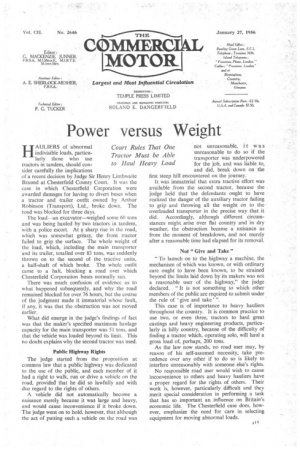Power versus Weight
Page 17

If you've noticed an error in this article please click here to report it so we can fix it.
HAULIERS of abnormal indivisible loads, particularly those who use tractors in tandem, should consider carefully the implications of a recent decision by Judge Sir Henry Linthwaite Braund at Chesterfield County Court. It was the case in which Chesterfield Corporation were awarded damages for having to divert buses when a tractor and trailer outfit owned by Arthur Robinson (Transport), Ltd., broke down. The road was blocked for three days.
The load—an excavator—weighed some 60 tons and was being hauled by two tractors in tandem, with a police escort. At a sharp rise in the road, which was somewhat greasy, the front tractor failed to grip the surface. The whole weight of the load, which, including the main transporter and its trailer, totalled over 83 tons, was suddenly thrown on to the second of the tractive units, a half-shaft of which broke. The whole outfit came to a halt, blocking a road over which Chesterfield Corporation buses normally ran.
There was much confusion of evidence as to what happened subsequently, and why the road remained blocked for over 76 hours, but the course of the judgment made it immaterial whose fault, if any, it was that the obstruction was not moved earlier.
What did emerge in the judge's findings of fact was that the maker's specified maximum haulage capacity for the main transporter was 51 tons, and that the vehicle was loaded beyond its limit. This no doubt explains why the second tractor was used.
Public Highway Rights The judge started from the proposition at common law that a public highway was dedicated to the use of the public, and each member of it had a right to walk, run or drive a vehicle on the road, provided that he did so lawfully and with due regard to the rights of others.
A vehicle did not automatically become a nuisance merely because it was large and heavy, and would cause inconvenience if it broke down. The judge went on to hold, however, that although thc act of putting such a vehicle on the road was not unreasonable, it was unreasonable to do so if the transporter was underpowered for the job, and was liable to, and did, break down on the first steep hill encountered on the journey.
It was immaterial that extra tractive effort was available from the second tractor, because the judge held that the defendants ought to have realized the danger of the auxiliary tractor failing to grip and throwing all the weight on to the overloaded transporter in the precise way that it did. Accordingly, although different circumstances might arise over flat country and in dry weather, the obstruction became a nuisance as from the moment of breakdown, and not merely after a reasonable time had elapsed for its removal.
Not "Give and Take" "To launch on to the highway a machine, the mechanism of which was known, or with ordinary care ought to have been known, to be strained beyond the limits laid down by its makers was not a reasonable user of the highway," the judge declared. "It is not something to which other members of the public are required to submit under the rule of 'give and take' ".
This case is of importance to heavy hauliers throughout the country. It is common practice to use two, or even three, tractors to haul great castings and heavy engineering products, particularly in hilly country, because of the difficulty of finding a tractor which, operating solo, will haul a gross load of perhaps, 200 tons.
As the law now stands, no road user may, by reason of his self-assumed necessity, take precedence over any other if to do so is likely to interfere unreasonably with someone else's rights.
• No responsible road user would wish to cause inconvenience to others and heavy hauliers have a proper regard for the rights of others. Their work is, however, particularly difficult and they merit special consideration in performing a task that has so important an influence on Britain's economic life. The Chesterfield case does, however, emphasize the need for care in selecting equipment for moving abnormal loads.




































































